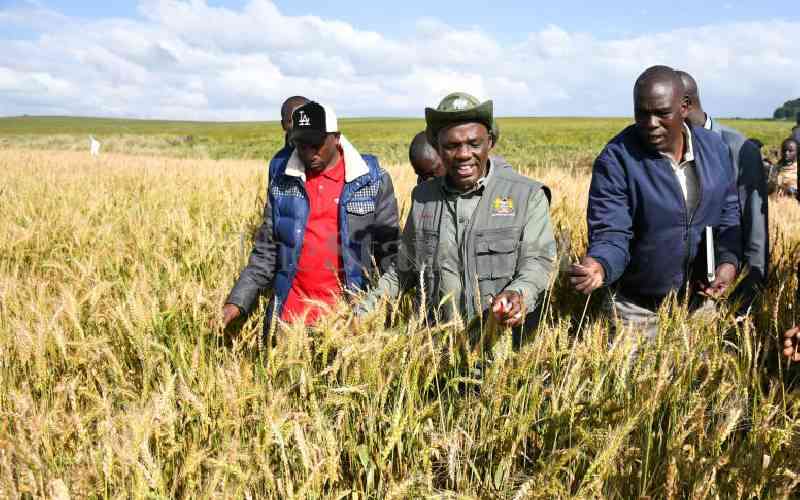Irene left university last year with a ‘coveted’ and ‘marketable’ degree in international relations, hope and enthusiasm in her heart and a firm conviction in her mind that she was destined for a high-flying career in international diplomacy and politics. Her exuberance, however, was soon tempered by the realisation that, after four years of university, there are no jobs out there, and even with the available vacancies, one needs to have three or more years of experience. After a couple of months ‘tarmacking’, she settled on what most would consider an unusual path.
“I am a farmer now,” she proclaims, proudly presenting a seven-page Excel worksheet illustrating a plan of action that would flummox all but the most seasoned – or daring – of takers. “People need strawberries; I know how to grow them. I have seen family and friends farm, so for me, it was an easy decision. Plus, it’s better than staying in the house, waiting for the parents to provide!”
Way out
Many Kenyan youth find themselves in Irene’s shoes, with few employment prospects at the end of their formal education. But even though agriculture has been a mainstay of Kenya’s economy for as long as the country has existed, unlike Irene, very few youths consider turning to agriculture as a source of livelihood.
The key challenge, therefore, is how to get our youth into an industry as old as civilisation itself, a sector so critical that President Uhuru Kenyatta recently pronounced agriculture and food security as one of the four pillars of his platform to continuing Kenya’s emergence as a middle-income country.
The solution to this challenge lies in our appreciation of a few salient facts. Most notable is that over 60 per cent of Kenya’s estimated population of 48 million are below the age of 30. Of this considerable cohort, an overwhelming majority are either unemployed or underemployed, and this despite being well-educated.
Several challenges, real or perceived, dissuade the youth from getting involved in agriculture. Chief among them is market access restrictions.
In addition to not always having a ready market, infrastructure to markets is often lacking or wanting. Then there is the risk of losses due to lack of storage facilities. Moreover, most youth don’t have access to the most basic agricultural resource; land. And even if they did, lack of basic knowledge and skills makes most youth shy away from this sector. Finally, the youth have difficulty getting access to non-collateralised loans. All these facts and challenges mean that, even though Kenya has always been a heavily agrarian economy, it’s most potent, competent demographic is giving agriculture a pass.
“Serikali saidia!” is a cry that, although many would like to ignore, poignantly shows that in many instances, the Government is the only recourse for most Kenyans to securing their well-being.
The Government should, therefore, look for solutions to some of these challenges to reposition the sector for the youth. To start with, education is the best bet to get more young people involved in agriculture.
Involving youth
Respected agriculture ambassadors could leverage youth and media partnerships to change perceptions, especially to show that there is money to be made in agriculture - and also make agriculture look ‘cool’. The youth should also be educated on farming techniques and technology, while the school curriculum should strive to paint agriculture positively. Innovative land tenure systems that give youth farmers access to idle or community land should also be explored. Finally, the Government would do well to facilitate access to collateral-free credit through the Uwezo/Youth funds.
Also, given that agriculture is a devolved function, it is obvious that while the central government can only do so much to make agriculture attractive to and viable for the youth, counties have a major role to play.
Counties can do this by creating agribusiness strategies that provide markets for local produce, aggressively pursuing markets - even using ICT solutions such as mFarm, where farm produce is readily sold - creating storage, packaging, and processing facilities close to farmers and reviving extension services.
Stay informed. Subscribe to our newsletter
Irene is not waiting for serikali. She found out that, even with the Government’s and stakeholders’ best intentions, creating non-agricultural jobs might not happen in the short term. “A friend allowed met to use his prime urban residential plot, which had been lying idle, to grow my strawberries. My initial cash investment is Sh40, 000.
It will take three months for me to start harvesting runners, four months for the fruit. My estimated earnings are approximately Sh282, 000 each harvest cycle from the one acre my friend has allowed me to use…”
It might just be time for the Government – and the youth, as well – to sit up and take notice of this sector and its opportunities.
Mr Nyakera is the Planning and Statistics principal secretary.
 The Standard Group Plc is a
multi-media organization with investments in media platforms spanning newspaper
print operations, television, radio broadcasting, digital and online services. The
Standard Group is recognized as a leading multi-media house in Kenya with a key
influence in matters of national and international interest.
The Standard Group Plc is a
multi-media organization with investments in media platforms spanning newspaper
print operations, television, radio broadcasting, digital and online services. The
Standard Group is recognized as a leading multi-media house in Kenya with a key
influence in matters of national and international interest.
 The Standard Group Plc is a
multi-media organization with investments in media platforms spanning newspaper
print operations, television, radio broadcasting, digital and online services. The
Standard Group is recognized as a leading multi-media house in Kenya with a key
influence in matters of national and international interest.
The Standard Group Plc is a
multi-media organization with investments in media platforms spanning newspaper
print operations, television, radio broadcasting, digital and online services. The
Standard Group is recognized as a leading multi-media house in Kenya with a key
influence in matters of national and international interest.









